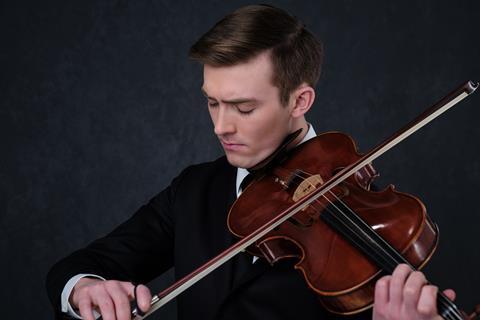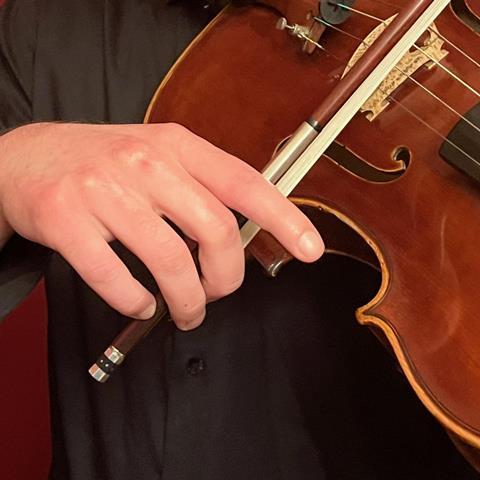Violist Daniel Orsen is unable to bend his right index finger, due to a previous injury. Barbara Khristi describes the tailor-made team efforts behind her former student that helped him launch his career

Discover more Featured Stories like this in The Strad Playing Hub
To blow is not to play on the flute; you must move the fingers – Johann Wolfgang von Goethe, Sprüche in Prosa, III.
Viola players advance in many directions when their formal education concludes. Daniel Orsen has arrived at the St. Paul Chamber Orchestra. But getting there didn’t seem possible at first. I was there only in the beginning, as his teacher.
That first lesson presented a real puzzle. His index finger stuck straight out over the bow. When the injury happened, it didn’t seem like much at first. But he couldn’t bend his finger even after a couple of months. Surgery was done to fix the unbendable digit. But, it failed. The anomaly that saved everything was that his nerve and artery between the two tendons were not affected. It was such an oddity that other doctors came to see it in the operating room.
He permanently lost the ability to bend his right index finger around anything, let alone a viola bow. In spite of the demand for intricate maneuverability when playing a bowed instrument, Daniel figured it out. To quote his teacher, Kim Kashkashian, ‘I believe he was not hindered by the lack of flexibility in one finger…I do not think anything could stop Daniel!’

I had questions about what happened after his time with me. So, I asked Daniel, his parents, other teachers, and his luthier and archetier.
His parents, both Lutheran ministers, provided enrichment through exposure to classical and jazz music, his mother being a jazz clarinettist. They faithfully devoted much time, energy and funding wherever his desire to play led. Not enough can be said for how they went the extra mile. I count these beautiful souls as the first part of the team that blessed his talents.
Parents in tow, we went off to the luthier’s shop. Phillip Injeian gave us all a private tour of his workshop. I knew Daniel needed a good viola to play. If he didn’t enjoy the sound he was making, he would likely quit. The investment was secondary to the impact of the big grin and the sparkling eyes on his son’s young face. So it was that he came away with an instrument that he took close to his heart, gave it a name and in earnest.
When asked about his journey, Daniel talked about his teachers, his luthier and archetier. Those I spoke to, the teachers Marylene Gingras-Roi and Kim Kashkashian among the impressive list, and the craftsmen, Phillip Injeian and Benoît Rolland, made a superlative team.
Viola players know that pain and long term injury can result if issues of tension are not addressed. With Marylene, Daniel began experimenting with ways to overcome tension that was magnified by having a tricky bow hand. In his words, ‘When [my bow] was finally working, it released the tension all over my body.’
He devised a solution that he continues to use. It began as Scotch tape pulling the finger down onto the bow grip. Kim Kashkashian teased that she would write to the 3M Company suggesting they grant Daniel a lifelong sponsorship! He now uses gaffer tape, something which is stickier and more flexible because of its fabric composition.
Peter Slowik recalled his years at Oberlin with Daniel: ‘The index finger (where Dan’s injury occurred) is pivotal in sound production – it’s the key “power finger” of the bow hand. It’s remarkable to me that someone with limited use of that finger could produce such a compelling sound.
‘Daniel never displayed any self-pity about his condition. While others tightened their bows, Daniel calmly taped his fingers. Considering he’s done this for each practice session, rehearsal, and concert – by my estimation he’s spent about 200 hours taping his fingers in preparation for his artistry.’
I wanted to know how he came to commission his instrument and bow. He told me that, ’In both cases, after looking at many different violas and bows, I deemed that commissioning was the best option for getting equipped. And I trusted Phil and Benoît based on their reputations, other artists who played on their instruments/bows, and what I had personally experienced of their instruments/bows…I was just doubling down on what I knew and what already felt good to me.’
Injeian told me that the viola was designed to get the darker, deeper sound that Daniel wanted. Its greater depth inside and the ribs made wider create the volume and the colour range without lengthening the viola. His viola elicited the comment from a judge on the jury of the Primrose International Competition that it has a ‘true viola sound.’ His viola has since been copied by luthier Tomas Pospichal in Germany and is labeled the Orsen Model.
A custom bow completes his superior equipment. Daniel recalls ‘I played twice for [Benoît] while he made observations. I would be curious to see his notes.’ Benoît obliged me with his detailed response. ‘If I remember well, Daniel Orsen was leaning his bow quite a lot, that’s why the Galliane frog suited him better than any conventional frog.’
Clearly Daniel has remarkable talent. With his determination, and with his team of teachers, luthiers and archetiers, and his family, he defied the odds and takes his place among the world’s finest players. As he devotes himself to the Wagner’s Nightmare project, I eagerly await what is next. Some questions are answered. The next question is, where will he go from here?
Read: Your violin, your legacy: the story of my violin, ‘Mrs. Evans’
Read: Matthew Barley: How a skiing injury changed the way I play
Read more Featured Stories like this in The Strad Playing Hub
The number one source for playing and teaching books, guides, CDs, calendars and back issues of the magazine.
In The Best of Technique you’ll discover the top playing tips of the world’s leading string players and teachers. It’s packed full of exercises for students, plus examples from the standard repertoire to show you how to integrate the technique into your playing.
The Strad’s Masterclass series brings together the finest string players with some of the greatest string works ever written. Always one of our most popular sections, Masterclass has been an invaluable aid to aspiring soloists, chamber musicians and string teachers since the 1990s.
American collector David L. Fulton amassed one of the 20th century’s finest collections of stringed instruments. This year’s calendar pays tribute to some of these priceless treasures, including Yehudi Menuhin’s celebrated ‘Lord Wilton’ Guarneri, the Carlo Bergonzi once played by Fritz Kreisler, and four instruments by Antonio Stradivari.






































No comments yet